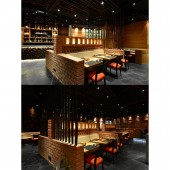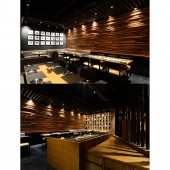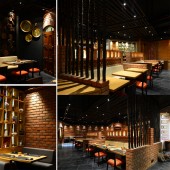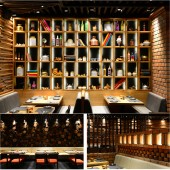
| THE AWARD |
| CATEGORIES |
| REGISTRATION |
| SUBMIT YOUR WORK |
| ENTRY INSTRUCTIONS |
| TERMS & CONDITIONS |
| PUBLICATIONS |
| DATES & FEES |
| METHODOLOGY |
| CONTACT |
| WINNERS |
| PRESS ROOM |
| GET INVOLVED |
| DESIGN PRIZE |
| DESIGN STORE |
| THE AWARD | JURY | CATEGORIES | REGISTRATION | PRESS | WINNERS | PUBLICATIONS | ENTRY INSTRUCTIONS |
Wah Marathi Restaurant and Bar by Ketan Jawdekar |
Home > Winners > Design #31131 >Interview |
 |
|
FS: What is the main principle, idea and inspiration behind your design?
KJ: The eating-out culture has gained tremendous momentum over the years. People have become very adventurous in their food choices and experiment with different cuisine styles from across the world. While this in itself is not at all a bad thing, what too much of extraneous influences do is that they overshadow local identity. The décor of this restaurant was inspired by this thought. And therefore the concept of a Maharashtrian ( Major state of India) flavoured décor for a Maharashtrian specialty cuisine restaurant located in a mall in Pune ( Major IT hub in India), the hub of Marathi culture; seemed perfect. Theme decors are fun; but can get monotonous over time. In that sense a contemporary styling manages to interest patrons more; and that is necessary to draw them to the F&B outlet over and over again. Therefore, a subtle fusion of aesthetics was selected. As a result, rural materials and objects are seen woven into the contemporary fabric.
FS: What has been your main focus in designing this work? Especially what did you want to achieve?
KJ: Very often, Indian Regional Cuisine restaurants use Indian motifs and design elements in the décor. Here the attempt is to take out only essential extracts from Maharashtrian regional culture and infuse the otherwise contemporary styling using recycled and natural materials with a touch of rural Maharashtra. The fusion of earthy and contemporary extends a very different experience for the patrons.
FS: Why did you design this particular concept? Was this design commissioned or did you decide to pursuit an inspiration?
KJ: Restaurant décor is a highly challenging area of design. The aesthetics chosen need to appeal to the patrons and stay fresh and interesting over time. The client’s brief therefore needs to be understood thoroughly and adapted sensitively to the décor. As the designers, we try to add value by sharing the benefits of our experience and expertise, with the client. Many of us have visited our family homes in villages and experienced the traditional homes, food, habits and way of life. The décor was based on the concept of creating a sense of nostalgia in the local patrons’ minds subtly; without letting the cultural overtones completely overpower the space. Therefore the base for the styling was chosen to be contemporary; with certain elements lending the nostalgic touches – to create an overall delightful fine dining experience.
FS: Who is the target customer for his design?
KJ: The overall ambiance of the restaurant is a fusion of traditional earthy elements with a contemporary design as a base. It gives an international look to the restaurant and encourages even the expats in the city to step in and experience the regional cuisine.
FS: What sets this design apart from other similar or resembling concepts?
KJ: Very often, Indian Regional Cuisine restaurants use Indian motifs and design elements in the décor. Here the attempt is to take out only essential extracts from Maharashtrian regional culture and infuse the otherwise contemporary styling using recycled and natural materials with a touch of rural Maharashtra. The fusion of earthy and contemporary extends a very different experience for the patrons.
FS: What is the most unique aspect of your design?
KJ: In a restaurant the sensory perceptions of the space dominates the level of appeal. With simplicity as the primary guiding factor, an earthy look was chosen and splashes of bold colors were introduced through various elements such as traditional local artifacts, displays and merchandise. An engaging play of light and shade – with a cleverly designed lighting pattern enhances the divine experience generated through organic components like wood and stones. The overall experience though quite emotive, showcases Indian/Maharashtrian culture and philosophy ingeniously; without compromising on the functional and visual factors. The restaurant does its bit towards the underprivileged sections of Maharashtrian society, by displaying and selling home made Indian spices. The most important design decision was to use indigenous materials and traditional construction techniques. Exposed brick work with wire-cut bricks and creative use of brick-bonds is a highlight in the central portion of the restaurant. Two long walls separating the two sections are clad with horizontal strips of wastage from wooden planks and raw wooden slices; in an attempt to recreate the effect of dry stone masonry and random stone masonry on the compound walls of Maharashtrian villages. The raw wooden logs cladding on the counter wall is symbolic representation of ancient stone masonry structure in rural India and particularly in Maharashtra. The flooring in leather-finished black local stone (Cudappah) is reminiscent of old Dravidian architecture.
FS: Any other things you would like to cover that have not been covered in these questions?
KJ: The subtle but distinct Marathi flavour seeps into the décor at the entry point itself. The lobby has the display of Indian spices and regional merchandise such as pickles and snacks; made by the womenfolk of economically weaker sections of society in the state of Maharashtra. Programmatically the restaurant is divided into two sections. The lower section at the entry hall has couple seating separated by a low height exposed bricks using interesting bonds of brick masonry. Openings in this wall relate to the special lighting features (konadas) in traditional construction methods. A screen of vertical pine wood members (locally called mundas). The upper section is raised by a step; with seating designed to cater to larger groups or families. Calligraphy frames in the ancient Indian Devnagari script placed on the black wall is a unique way of engaging guests while they are waiting for the food to be served. The other side of this section displays various artifacts from the Maharashra region like the very famous wooden toys from Sawantwadi, bottles filled with rangoli (the traditional art of creating designs on the floor with coloured sand), famous literature in Marathi and traditional Maharashtrian sarees. Ceiling is kept exposed and is painted black to give the effect of having dinner under the twinkling stars in an open courtyard of a rural house. The overall ambiance of the restaurant is a fusion of traditional earthy elements with a contemporary design as a base. It gives an international look to the restaurant and encourages even the expats in the city to step in and experience the regional cuisine.
FS: Thank you for providing us with this opportunity to interview you.
A' Design Award and Competitions grants rights to press members and bloggers to use parts of this interview. This interview is provided as it is; DesignPRWire and A' Design Award and Competitions cannot be held responsible for the answers given by participating designers.
| SOCIAL |
| + Add to Likes / Favorites | Send to My Email | Comment | View Press-Release | Translations |




